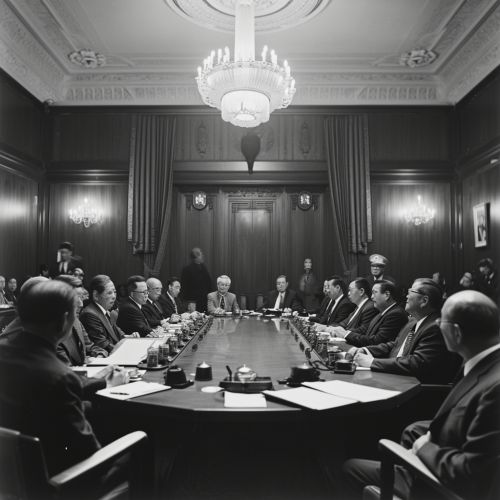Central Committee of the Communist Party of the Soviet Union
Formation and Early History
The Central Committee of the Communist Party of the Soviet Union (CPSU) was established in 1912, following the 6th Congress of the Russian Social Democratic Labour Party. The committee was initially composed of Bolshevik leaders who were instrumental in the October Revolution of 1917.


The Central Committee's primary function was to elect the Politburo, the Secretariat, and the General Secretary, the highest office in the Soviet Union. The committee was considered the highest authority within the Communist Party between each party congress.
Structure and Function
The Central Committee was composed of full and candidate members. Full members had voting rights while candidate members did not. The number of members varied over time, ranging from a few dozen to several hundred. Members were elected by the party congress and served until the next congress, typically held every five years.
The Central Committee met at least twice a year for plenary sessions, known as "plenums". These meetings were used to discuss and decide on major policy issues. Between plenums, the work of the Central Committee was carried out by the Politburo, the Secretariat, and the Orgburo.
Role in Soviet Governance
The Central Committee played a crucial role in the governance of the Soviet Union. It was responsible for the overall direction of the party and the state. The committee had the authority to interpret party policies and could issue directives to all party and state organizations.
The Central Committee also had the power to elect the General Secretary, who was the de facto leader of the Soviet Union. The General Secretary was responsible for the day-to-day administration of the party and the state, and had significant influence over domestic and foreign policy.
Influence and Power Dynamics
The power dynamics within the Central Committee shifted over time, reflecting the changing political landscape of the Soviet Union. During the early years of the Soviet Union, the Central Committee was a forum for vigorous debate and decision-making. However, under the leadership of Joseph Stalin, the committee became a rubber-stamp body, with decisions made by the General Secretary and a small circle of allies.
Following Stalin's death in 1953, the Central Committee regained some of its former influence. Under Nikita Khrushchev and his successors, the committee became more involved in policy-making, although the General Secretary retained ultimate authority.
Dissolution and Legacy
The Central Committee of the CPSU was dissolved in 1991, following the failed August Coup and the subsequent collapse of the Soviet Union. The committee's dissolution marked the end of the Communist Party's rule in Russia.
The legacy of the Central Committee is complex. While it was instrumental in the governance of the Soviet Union, its role was often overshadowed by the power of the General Secretary. The committee's history reflects the broader political dynamics of the Soviet era, from the revolutionary fervor of the early years to the bureaucratic stagnation of the later period.
